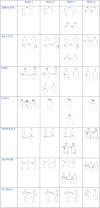Disentangling Pantomime From Early Sign in a New Sign Language: Window Into Language Evolution Research
- PMID: 33935890
- PMCID: PMC8080026
- DOI: 10.3389/fpsyg.2021.640057
Disentangling Pantomime From Early Sign in a New Sign Language: Window Into Language Evolution Research
Abstract
In this study, we aim to disentangle pantomime from early signs in a newly-born sign language: Sao Tome and Principe Sign Language. Our results show that within 2 years of their first contact with one another, a community of 100 participants interacting everyday was able to build a shared language. The growth of linguistic systematicity, which included a decrease in use of pantomime, reduction of the amplitude of signs and an increase in articulation economy, showcases a learning, and social interaction process that constitutes a continuum and not a cut-off system. The human cognitive system is endowed with mechanisms for symbolization that allow the process of arbitrariness to unfold and the expansion of linguistic complexity. Our study helps to clarify the role of pantomime in a new sign language and how this role might be linked with language itself, showing implications for language evolution research.
Keywords: early signs; emergent sign language; human communication; language evolution; pantomime.
Copyright © 2021 Mineiro, Báez-Montero, Moita, Galhano-Rodrigues and Castro-Caldas.
Conflict of interest statement
The authors declare that the research was conducted in the absence of any commercial or financial relationships that could be construed as a potential conflict of interest.
Figures






References
-
- Adone D. (2012). The Acquisition of Creole Languages: How Children Surpass their Input. Cambridge: Cambridge University Press. 10.1017/CBO9781139043366 - DOI
-
- Arbib M. A. (2012). How the Brain Got Language: The Mirror System Hypothesis. New York, NY: Oxford University Press. 10.1093/acprof:osobl/9780199896684.001.0001 - DOI
-
- Arbib M. A. (2013). Précis of How the brain got language: the mirror system hypothesis. Lang. Cogn. 5, 107–131. 10.1515/langcog-2013-0007 - DOI
-
- Armstrong D. F., Stokoe W. C., Wilcox S. E. (1995). Gesture and the Nature of Language. Cambridge: Cambridge University Press. 10.1017/CBO9780511620911 - DOI
-
- Aronoff M., Meir I., Padden C., Sandler W. (2003). “Classifier constructions and morphology in two sign languages,” in Perspectives on Classifier Constructions in Sign Languages, ed Emmorey K. (Mahwah: Lawrence Erlbaum Associates Publishers; ), 53–84.
LinkOut - more resources
Full Text Sources
Other Literature Sources

